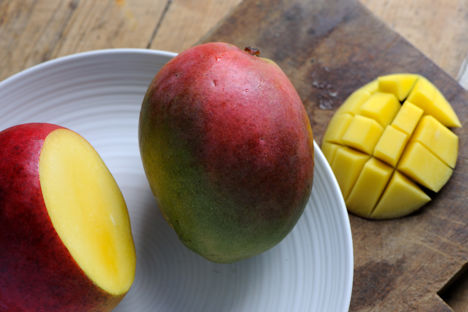
Ingredient focus: mango
At the height of their season in July, mangoes are in their prime right now. Fortunately last year’s UK ban on mango imports has now been lifted and we are free to enjoy this tropical treat once more. Look to specialist Asian stores and online for the highest quality varieties and buy by the box for the best value.
Ingredient focus: mango
At the height of their season in July, mangoes are in their prime right now. Fortunately last year’s UK ban on mango imports has now been lifted and we are free to enjoy this tropical treat once more. Look to specialist Asian stores and online for the highest quality varieties and buy by the box for the best value.
Mangoes originated in the area of South Asia once known as India, and which now makes up India, Pakistan and Bangladesh. India still produces over half of the world’s mangoes but is accountable for only 1% of export as they are mostly eaten in the country. There are more than 400 varieties of mango available worldwide, with the Indian Alfonso and Kesir varieties and the Chaunsa mango from Pakistan widely being considered to be the best in flavour and texture. Mangoes found in British supermarkets tend to be Kent or Tommy Atkins. These mangoes have been bred to last longer without spoiling, although the flavour and texture is generally of inferior quality to their Asian counterparts. Equally important in the quality of mango is the ripeness. Mangos take between three and six months to ripen on the tree, but more often the mangoes imported into Britain have been picked unripe and left to ripen on the long boat journey.
Mangoes have been grown for at least 5000 years and are steeped in cultural history. Buddha is believed to have found rest under a mango tree, and mangoes are widely considered a symbol of love and friendship. The mango is the national fruit of India, Pakistan and the Philippines. The first recording of Mangoes consumption in Europe was in 1510.
Flavour profile
There are many volatile organic chemicals in the soft pulp of the mango which individually release different characters depending on variety and ripeness but its general characteristic flavours are fruity, sweet and creamy.
The flavour of ripe mango can be likened to that of peach, apricot and even melon. Underripe mango is sour and acidic while over ripe mango begins to get a soapy taste, sometimes likened to turpentine. It is often cited as a flavour when wine tasting to represent a smooth but fruity richness in white wine.
Food matches
Mango lends itself well to both sweet and savoury dishes but perhaps its best friend is lime, with the slight floral notes and acidity of the citrus fruit lifting the mango flesh to a whole new level with just a few drops of its juice. Other fruits that pair well with mango are apple (especially granny smith), peach and apricot as they have the same flavour notes.
Spices such as cardamom, chilli and cumin work very well with mango, just be careful not to overpower the flavour of the fruit; think of the flavour balance in a spicy mango chutney. The floral notes in coriander and the spice of fresh ginger complement mango, as does the sharp acidity of pineapple. Coconut is another great pairing to mango, with their tropical flavours working perfectly together giving an incredible result.
Mango finds its way into savoury preparations when served with white fish such as turbot or gentle, sweet shellfish like crab, scallops and prawns. Avocado is a delicious addition to any of these combinations.
Did you know?
The leaves of mango trees are used as decoration at weddings in South Asia.
It takes 35 years for a mango tree to produce good quality fruit and after this it will continue to fruit for 300 years.
When dried and ground mango is known as the spice, amchoor. It gives an unrivaled acidity to dishes, especially curries and chutneys.


